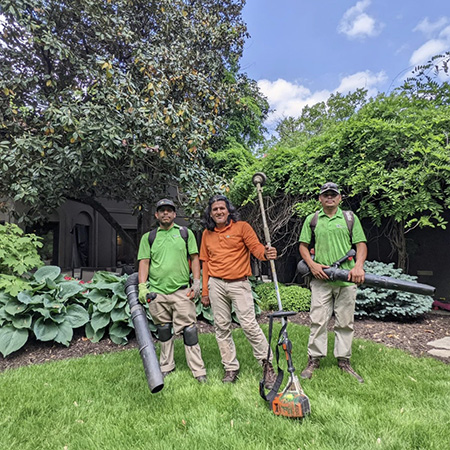Transform Your Exterior Space: Landscaping San Marcos Experts
Transform Your Exterior Space: Landscaping San Marcos Experts
Blog Article
Specialist Landscape Design Solutions for Sustainable Outdoor Transformation
Enhancing outdoor rooms via specialist landscaping services can use more than just aesthetic charm; it can cultivate a sustainable setting that profits both homeowner and the earth. From selecting native plants to carrying out water preservation techniques and utilizing eco-friendly hardscape remedies, the possibilities for lasting outdoor change are vast. By recognizing the value of upkeep methods that sustain sustainability, specialist landscapers can really make a long lasting impact on the outside rooms they work on.
Benefits of Sustainable Landscaping
Lasting landscaping supplies many environmental and economic advantages for both building proprietors and the neighborhood. By implementing sustainable techniques such as xeriscaping, making use of indigenous plants, and minimizing water use, residential or commercial property owners can considerably lower their environmental impact. These techniques not just conserve water yet likewise advertise biodiversity and decrease the need for hazardous chemicals and plant foods.

From an area point of view, lasting landscape design plays a vital duty in boosting air and water quality, lowering city warm island effects, and supplying habitats for regional wildlife. These advantages add to developing much healthier and more lasting settings for everybody to appreciate.
Indigenous Plants Option and Design
When intending a landscape style, choosing native plants is crucial for maximizing sustainability and community health. Native plants are adapted to the local environment, soil conditions, and insects, making them low-maintenance and a lot more resistant to grow in their native environment. Integrating native plants into landscape design designs not just improves biodiversity however additionally supports pollinators, helpful insects, and local wild animals.
Creating with indigenous plants entails cautious consideration of factors such as plant size, development practice, blossom time, and water needs to create a sustainable and aesthetically appealing landscape. By choosing a diverse selection of native plants, landscape designers can create balanced ecological communities that bring in a selection of species and add to the overall wellness of the atmosphere.
Additionally, indigenous plants can help in reducing water usage, reduce the requirement for chemical pesticides and fertilizers, and improve dirt top quality through their all-natural processes. With appropriate option and style, native plants can change exterior areas right into thriving, sustainable landscapes that profit both the environment and the area.
Water Preservation Techniques
Including indigenous plants right into landscaping designs not just enhances biodiversity but additionally supports pollinators, advantageous bugs, and regional wildlife, which highlights the value of implementing water preservation strategies in landscaping techniques. Water conservation is essential for sustainable exterior areas, particularly in areas susceptible to Related Site dry spell or water deficiency.

Eco-Friendly Hardscape Solutions
The application of eco aware products imp source in hardscape style is a pivotal element of developing sustainable outside areas. Eco-friendly hardscape solutions encompass a variety of methods focused on lowering ecological impact while enhancing the appearances and performance of exterior locations. Incorporating materials such as permeable pavers, reclaimed timber, recycled plastics, and natural stone can dramatically reduce the eco-friendly impact of hardscape installments.
Absorptive pavers, for instance, allow rainwater to leak right into the ground, minimizing runoff and avoiding water pollution - Landscaping San Marcos. Recycled plastics can be changed right into low-maintenance and resilient hardscape aspects, using a sustainable choice to standard products.
Maintenance Practices for Sustainability
To promote the ecological stability of environment-friendly hardscape solutions, executing tactical maintenance techniques is crucial for making certain long-lasting sustainability in exterior landscaping tasks. Regular maintenance not only protects the aesthetic charm of the landscape yet also contributes to its total sustainability by minimizing environmental impact.
One secret upkeep technique for sustainability is appropriate irrigation management. Reliable watering strategies, such as drip irrigation systems or rainwater harvesting, aid save water and advertise plant health and wellness. Additionally, regular evaluation and modification of irrigation systems can stop water wastage and make certain optimum hydration for plants.
Another important find more info aspect of lasting upkeep is the liable use chemicals and plant foods. Selecting organic fertilizers and employing incorporated pest management strategies lessens harmful chemical overflow into the setting, securing both plant life and community balance.
Additionally, routine cleansing and upkeep of hardscape functions like permeable pavers or stone pathways avoid particles buildup and keep performance while sustaining water seepage and drainage, hence reducing the danger of disintegration and flooding. Landscaping San Marcos. By sticking to these lasting maintenance techniques, outside landscapes can grow harmoniously while decreasing their eco-friendly impact
Conclusion
To conclude, sustainable landscaping uses many benefits with making use of native plants, water preservation methods, green hardscape services, and sustainable maintenance techniques. By carrying out these approaches, exterior spaces can be transformed right into environmentally-friendly and cosmetically pleasing locations that sustain biodiversity and decrease ecological influence. Buying specialist landscape design solutions that prioritize sustainability can cause long-lasting benefits for both the setting and property proprietors.
From choosing indigenous plants to carrying out water conservation methods and using environment-friendly hardscape solutions, the opportunities for sustainable outside improvement are substantial. By executing lasting practices such as xeriscaping, making use of native plants, and reducing water use, residential or commercial property proprietors can dramatically reduce their environmental effect. Water preservation is vital for sustainable outside rooms, specifically in regions susceptible to dry spell or water scarcity. By implementing these water conservation methods, landscaping experts can produce attractive, sustainable outdoor spaces that benefit both the setting and the community.
In conclusion, sustainable landscape design uses countless advantages via the use of indigenous plants, water preservation methods, eco-friendly hardscape options, and sustainable upkeep techniques.
Report this page